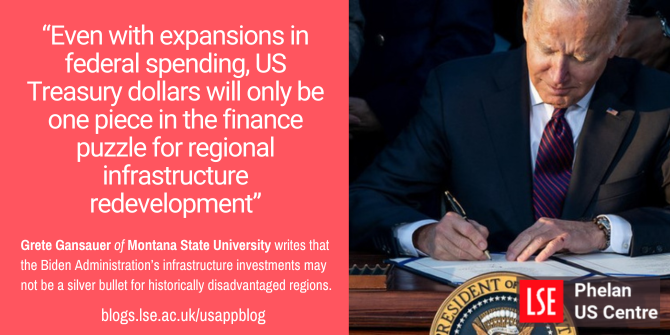 Over the past two years the Biden Administration has passed measures worth over $1.7 trillion to invest in America’s transportation, communications, water, and energy networks. Grete Gansauer writes that this investment may not be sufficient on its own to stimulate inclusive regional development in the US’ left behind places. Not only may national policy goals risk obscuring local social need, how infrastructure projects are financed could worsen fiscal inequalities between regions and reinforce existing structures which siphon value from declining regions towards already wealthy ones.
Over the past two years the Biden Administration has passed measures worth over $1.7 trillion to invest in America’s transportation, communications, water, and energy networks. Grete Gansauer writes that this investment may not be sufficient on its own to stimulate inclusive regional development in the US’ left behind places. Not only may national policy goals risk obscuring local social need, how infrastructure projects are financed could worsen fiscal inequalities between regions and reinforce existing structures which siphon value from declining regions towards already wealthy ones.
Reinvesting in US infrastructure for social equity
In what has been called a “once in a generation” investment in the nation’s infrastructure, the Biden Administration aims to reverse decades of underinvestment in US transportation, telecommunications, water and wastewater, and energy networks. Through the 2021 $1.2 trillion Infrastructure Investment and Jobs Act (also called the Bipartisan Infrastructure Law) and 2022’s $500 billion Inflation Reduction Act, the US is investing in capital improvements on a scale not witnessed in decades—with an explicit intention to repair deep socioeconomic, geographic, and racial inequalities in US society.
Leveraging the Biden Administration’s massive infrastructure reinvestment to (quite literally) build a more just economy will require that federal programs reach communities which have been marginalized by the present economy and respond to place-based infrastructure deficits. Areas which chronically lack investment and have experienced market failures in the provision of essential public goods such as broadband, rural regions and communities of color sorely need federal assistance to overcome the self-reinforcing downward fiscal spiral which can make local infrastructure and basic public service provision difficult or impossible.
However, infrastructure investment on its own is insufficient to stimulate the type of inclusive regional development which will be needed to repair geographic and racial divides within the US. The potential for expanded federal infrastructure spending to deliver on equity goals by sparking generative regional development outcomes in the ‘left behind’ regions of the US remains uncertain for at least three reasons.
New and expanded infrastructure systems may facilitate regional value extraction rather than value retention
Declining regional economies are characterized by value, people, and capital flowing outward and concentrating in more prosperous centers. In part, this dynamic is driven by regional dependence on export-oriented industries in decline: for example, coal-producing communities in Appalachia and the western US are on the precipice of grim economic futures already being lived out by the former manufacturing hubs of the rust belt. This production model poses fundamental barriers to regional economic development as wealth produced through local labor and resources is physically uprooted and builds up elsewhere.

“P20211115CS-2636-2” by The White House is United States government work
In a physical sense, networks of transportation, shipping, energy, and telecommunications infrastructures make such extractive economic relationships possible—and the incoming surge of federal infrastructure spending could reinforce such dynamics if this is not addressed. Resource- and energy-producing regions, which will be critical suppliers in a national clean energy transition, are particularly at risk for hosting large-scale infrastructure investments which may reinforce single-industry dependence and extractive market structures.
National policy goals risk obscuring local social need
Expanded federal infrastructure spending means that the federal government now has a much more prominent role than has been typical in the contemporary US. Federal investments don’t only have a social equity imperative, but also an explicit aim to maintain US economic competitiveness, stabilize supply chains through expanding domestic green technologies and advanced manufacturing production, and to transition to an economy powered by clean energy. Resource- and energy-producing regions and economically distressed regions with high prime-age unemployment rates (or, read in reverse, high latent labor market potential) are important to the success of broader national goals, and are thus targets for federal infrastructure expenditures.
Yet the extent to which the national goals attached to federal infrastructure investments align with place-based regional development needs in infrastructure development remains an open question. Declining areas are often places with chronic market failures in infrastructure systems which primarily serve social—rather than economic—aims. For example, private Internet Service Providers have failed to deliver broadband to low-population rural areas for decades because such places are not lucrative. As incoming federal investments bring national economic aims to the center, projects risk overshadowing or continuing to underinvest in such infrastructure and public services that have high social value.
On one hand, the extent to which projects respond to local needs will depend on the design and direction of federal programming; on the other, how effectively local stakeholders can advocate for their needs within planning and development processes will also be important. Marginalized communities—including resource-dependent regions and communities of color—often enter such negotiations at a disadvantage, and may have endured painful histories of federal infrastructure programming steamrolling local values or neglecting their social needs. Thus, the question of whether new infrastructure spending will adequately repair social sustainability in distressed places will depend partly on reconfiguring the power relations of implementation through a commitment to procedural justice.
Finance mechanisms could worsen fiscal inequalities between prosperous and declining regions
Even with expansions in federal spending, US Treasury dollars will only be one piece in the finance puzzle for regional infrastructure redevelopment. In addition to federal funds, the private sector will generally play a large role in financing broadband development and energy facilities, and state and local coffers will continue to be paramount sources of capital for transportation and water and wastewater systems.
Financing infrastructure through private capital sources risks introducing a profit motive into projects, which poses contradictions for projects in declining places and regions which have been historically subject to poor infrastructure provision. At the same time, under the US federal system, a lack of local financial capacity constrains local governments from developing adequate infrastructures. Marginalized geographies often find themselves in spirals of debt and disinvestment where low property values and a lack of taxable assets lead to inadequate public revenues relative to public service provision demands. In addition, local public revenues in rural and resource-producing regions of the US may be directly tied to commodity production—creating unreliable revenue streams which are exposed to market volatility and disincentivize economic diversification.
To deliver on equity goals, federal programming will need to reconfigure the incentive structures which historically deter capital from flowing into, and translating to local wealth for, distressed regions. To do so, federal programming will need to de-risk infrastructure finance by assuming the risk from prospective investors weary of directing capital toward disinvested regions, and from local institutions which are least able to bear it.
Spending infrastructure investment wisely for regional development
The Biden Administration’s ‘generational down payment’ on the nation’s infrastructure holds immense opportunity for reinvesting in communities with histories of dis- and under-investment. However, infrastructure on its own should not be taken as a ‘silver bullet’ for holistic regional development—particularly in disadvantaged regions where fiscal constraints, asymmetrical power relations, and infrastructure-enabled extractive market structures have contributed to their marginalization. To leverage infrastructure developments to repair social disparities, attention must be paid to the extent to which procedural justice in funding implementation translates into spatial justice in fund distribution. Otherwise, federal expenditures risk reinforcing—rather than mitigating—the structural drivers of regional decline.
- This article is based on the paper, ‘Can infrastructure help ‘left behind’ places ‘catch up?’ Theorizing the role of built infrastructure in regional development’ in the Cambridge Journal of Regions, Economy and Society.
- Please read our comments policy before commenting.
- Note: This article gives the views of the author, and not the position of USAPP – American Politics and Policy, nor the London School of Economics.
- Shortened URL for this post: https://bit.ly/3vSGCOg






